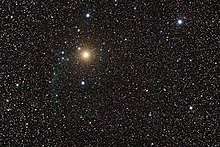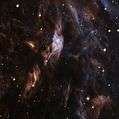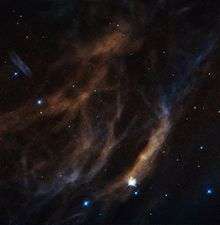Sh2-308
Sh2-308, also designated as Sharpless 308, RCW 11, or LBN 1052,[1] is an H II region located near the center of the constellation Canis Major, composed of ionised hydrogen.[2] It is about 8 degrees south of Sirius, the brightest star in the night sky. The nebula is bubble-like (hence its common name, the Cosmic Bubble), surrounding a Wolf–Rayet star named EZ Canis Majoris. This star is in the brief, pre-supernova phase of its stellar evolution. The nebula is about 4,530 light-years (1,389 parsecs) away from Earth,[3] but some sources indicate that both the star and the nebula are up to 5,870 ly (1,800 pc) away.[4][5] Yet others indicate the nebula is as close as 1,875 ly (575 pc) from Earth.[6]
| Emission nebula | |
|---|---|
 Sh2-308 visible as faint blue nebula, spreading from left of the bright orange star Omicron Canis Majoris (north is down) | |
| Observation data: J2000.0 epoch | |
| Class | 3 2 2 |
| Right ascension | 06h 54m 13s |
| Declination | -23° 55′ 42″ |
| Distance | 4530 ly |
| Apparent magnitude (V) | 7.0 |
| Apparent dimensions (V) | 35′×35′ |
| Constellation | Canis Major |
| Physical characteristics | |
| Radius | 30 ly |
| Designations | Sh-308, RCW 11, LBN 1052 |
Star
Sh2-308 surrounds the Wolf–Rayet star EZ Canis Majoris, also designated EZ CMa or WR 6. Its apparent magnitude varies from 6.71 to 6.95. Its spectral type indicates that the star is very hot and luminous. The spectrum shows that it is devoid of hydrogen at the surface.[7] EZ Canis Majoris is expected eventually to explode in a supernova, therefore subsuming the nebula.[8]
Formation
The nebula was formed about 70,000 years ago by the star EZ Canis Majoris throwing off its outer hydrogen layers, revealing inner layers of heavier elements.[2] Fast stellar winds, blowing at 1,700 km/s (3.8 million mph) from this star, create the bubble-shaped nebula as they sweep up slower moving material from an earlier phase of the star's evolution. The hydrogen composing the nebula is ionised by intense ultraviolet radiation.[9] The nebula is approximately 60 light-years across at its widest point.[10]
Observation
The most favorable period for observing the nebula in the night sky is between the months of December and April. Its southern declination makes it easier to observe from the Southern Hemisphere, though it is easily visible from most of the Northern Hemisphere as well. It appears as a faint cloud in photographs taken with high-power amateur instruments, with the help of special filters.
Gallery
 A portion of Sh2-308 to the west of EZ Canis Majoris
A portion of Sh2-308 to the west of EZ Canis Majoris A small portion of Sh2-308 imaged by the Hubble Space Telescope (up is north-west)
A small portion of Sh2-308 imaged by the Hubble Space Telescope (up is north-west)
References
- "Sh 2-308". SIMBAD. Centre de données astronomiques de Strasbourg. Retrieved 2017-04-30.
- "Inflating Sh2-308". www.spacetelescope.org. Retrieved 2017-05-22.
- van Leeuwen, F. (2007-11-01). "Validation of the new Hipparcos reduction". Astronomy and Astrophysics. 474 (2): 653–664. arXiv:0708.1752. Bibcode:2007A&A...474..653V. doi:10.1051/0004-6361:20078357. ISSN 0004-6361.
- "APOD: 2009 April 23 - Sharpless 308". apod.nasa.gov. Retrieved 2017-05-02.
- Morris, P W; Crowther, P A; Houck, J R (2004-06-01). "Spitzer-IRS Sectroscopy of the Prototype Wolf-Rayet star EZ CMa (HD 50896)". arXiv:astro-ph/0406074.
- Burningham, Ben; Naylor, Tim; Jeffries, R. D.; Devey, C. R. (2003-12-01). "On the nature of Collinder 121: insights from the low-mass pre-main sequence". Monthly Notices of the Royal Astronomical Society. 346 (4): 1143–1150. arXiv:astro-ph/0308488. Bibcode:2003MNRAS.346.1143B. doi:10.1111/j.1365-2966.2003.07160.x. ISSN 0035-8711.
- Hamann, W.-R.; Gräfener, G.; Liermann, A. (2006). "The Galactic WN stars". Astronomy and Astrophysics. 457 (3): 1015. arXiv:astro-ph/0608078. Bibcode:2006A&A...457.1015H. doi:10.1051/0004-6361:20065052.
- "Hubble Image of the Week - EZ Canis Majoris, Sh2-308". SciTech Daily. 2017-04-17. Retrieved 2017-05-26.
- Toalá, J. A.; Guerrero, M. A.; Ramos-Larios, G.; Guzmán, V. (2015). "WISE morphological study of Wolf-Rayet nebulae". Astronomy & Astrophysics. 578: A66. arXiv:1503.06878. Bibcode:2015A&A...578A..66T. doi:10.1051/0004-6361/201525706. ISSN 0004-6361.
- Hille, Karl (2017-04-21). "Hubble's Cosmic Bubbles". NASA. Retrieved 2017-04-30.
External links
| Wikimedia Commons has media related to Sh2-308. |
- Sh2-308 on WikiSky: DSS2, SDSS, GALEX, IRAS, Hydrogen α, X-Ray, Astrophoto, Sky Map, Articles and images